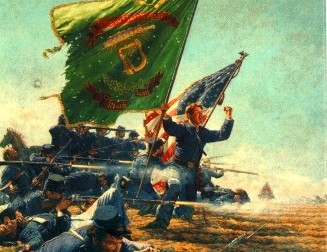| Colonel Daniel Kelly: Fought in 1860 for Pope Pius IX in Italy. He had joined the Irish Papal Brigade (The Battalion of St. Patrick) and participated in the desperate battles of Perugia, Spoleto and Castelfidardo against the 'robber-king' Victor Emmanuel. The Papal Army, overwhelmed by numbers, had to surrender at Ancona and the Irish contingent were sent home to a tumultuous reception at Cork. Kelly, then a Lieutenant, emigrated to the U.S.A. and joined the Federal army as an Irish Volunteer. His former service in the Papal Army and his ability commanded such attention that he was promoted to Captaincy and, later, he became Colonel of the 1st Louisiana Cavalry. |
He arrived in New York in June 1861 and enlisted, as a private, in Company K, 69th Regiment. He was promoted to Sergeant in early July and he distinguishing himself at Bull Run and Blackburn Ford. He then himself raised a company for the Irish Brigade and he was commissioned a Captain in the 88th Regiment. He took part in all the battles of the Peninsula up to Antietam on September 17th, 1862, where he was killed. As Meagher's brigade charged up the hill to the 'sunken road' they came under intense fire from the entrenched Confederates. Many were killed but the main body continued the advance until they were about thirty yards from the enemy. The colour bearers were all killed or wounded and Clooney dashed forward to grab the slours while, at the same time, ordering his men forward. The brigade attempted a bayonet charge but that was repulsed and they then commenced a furious volley of shots at the rebel lines. It was around mid-day, after the battle had been raging for about twenty minutes, that Clooney first receiving a severe gun-shot wound to the knee. He would not leave the field but struggled to his feet, using the flag-staff as a crutch. He was then hit twice - in the chest and heart, killing him instantly. A rudely carved cross, inscribed with Wallace's words "He like a soldier fell," was erected by his men (surely, considering the inscription, there were Waterford men there ) over his grave - the spot where he was slain. Captain Clooney was conspicuous by his commanding form and his green plume and he had a rich, manly, voice. The Company's second-in-command, Lieutenant John Byron, wrote to Clooney's father about the death of Clooney and he wrote that 'By his death Ireland lost one of her most devoted sons, the American Republic one of her bravest defenders, and the noble Irish Brigade one of its bravest soldiers.' His remains were later exhumed and removed to Calvary Cemetery, Woodside, Queen's, New York. Shortly after his death a committee was set up in Waterford to raise funds for the erection of a monument to Captain Clooney and in only a few short months, on February 21, 1863 the monument was unveiled in Ballybricken Churchyard. Captain Joseph Hyland: Also of the 88th, he was promoted from the ranks for his valour and ability. Wounded at Spotsylvania he was mustered out with his regiment at the end of the war. Surgeon Laurence Reynolds: Waterford-born surgeon Laurence Reynolds was a member of the 63rd New York Regiment. He was a "highly educated and refined gentleman and a very experienced surgeon." He became known as the "Poet Laureate of the Irish Brigade," writing several beautiful and touching poems on his native land. Witty and humorous, he had been a distinguished 'Chartist' in England and also a 'Young Irelander', having to flee from Waterford in 1848. He was 'centre' of the Potomac Fenian circle. His brother Frank Reynolds was a surgeon in the 88th. Captain Charles J. Quirk: A native of Lismore, Co. Waterford he joined Company K, 63rd Regiment in October 1861 and served in every engagement until June 1863 when, on the consolidation of the regiment, he was honourably mustered out. He had enlisted as a private, been promoted to Sergeant-Major and then, in October 1862 to First-Lieutenant and, afterwards, to Captain. Lieutenant
John Dillon: A native of
Dungarvan, Co. Waterford he had also joined the 63rd as a private and he
served as 'Colour Sergeant' with distinction in many battles. He
was promoted to Second Lieutenant for planting the Federal flag on the
enemy's works at Cold Harbor in January 1865. He was mustered out
in April that year, a short time before the close of the war. |
